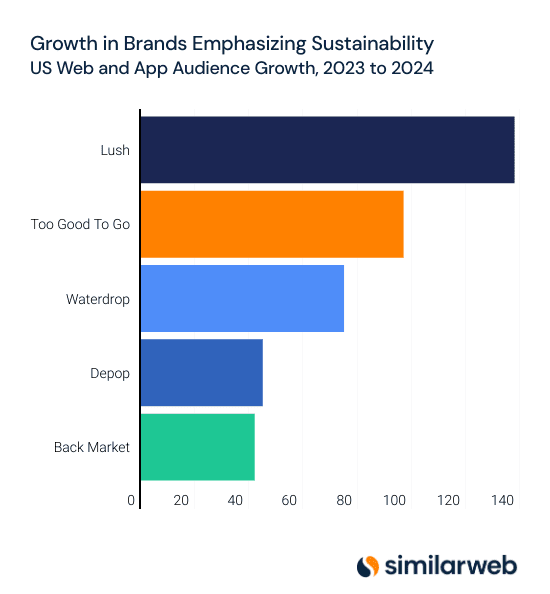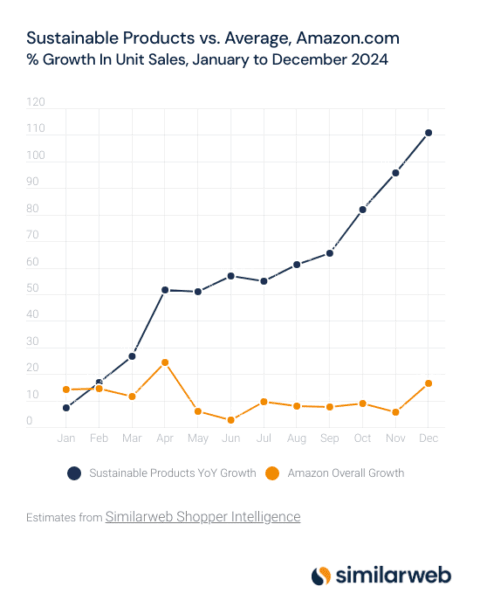In the past year, one winning pattern with the Similarweb Digital 100 fastest-growing digital businesses was sustainability. Appealing to consumer interest in environmental responsibility and waste reduction allowed multiple brands to achieve outstanding web and app growth, even in challenging sectors like fashion and apparel where the broader industry trends were negative.
Is that a trend likely to last in 2025, a year when environmental concerns are being dismissed as “woke” and irrelevant to the bottom line – while inflation and worries about tariff wars are intensifying?
Actually, yes – at least when the “good for the planet” message aligns with “good for saving money,” a combination that has proven especially effective for many of this year’s Digital 100 winners.
How Recycled and Reused Products are Changing Shopping
The rise of the “circular economy” — where products are reused, resold or repurposed — stood out in our U.S. ranking of digital growth from 2023 to 2024, along with brands that practiced and promoted sustainability through their products.
Advertisement
Winners included beauty brand Lush, which emphasizes sustainable packaging (web visitors up 138%); food waste reduction service Too Good to Go (monthly app users up 97%): reused and repurposed fashion marketplace Depop (45% app user growth); eco-friendly home goods maker Waterdrop Filter (web visitors up 75%); and refurbished electronics seller Back Market (app users up 42%). In the beauty and wellness and home and garden categories, ethically sourced, eco-friendly brands gained prominence.
Meet the Sustainability-Focused Digital 100 Brands

While we are mixing two different digital metrics, for websites and apps, both represent channels for audience and customer growth. Our full insights report breaks down the web and app winners in detail, but by definition, every company in the report grew its digital presence faster than the market.
Certainly, consumers are worried about the economy and inflation – and have been for some time – but in 2024, a significant segment of consumers was still attracted to brands with an emphasis on sustainability and environmental stewardship.
These brands make a point of emphasizing their social mission. For example, website marketing messages at:
- Lush: “We believe taking care of the environment is everyone’s responsibility including all of our staff and our customers.”
- Back Market: “Buy and sell tech that’s better for the planet.”
- Depop: “Buy for less. Sell for free. Keep fashion circular.”
Younger Consumers are Leading the Trend
As we see in the data, younger consumers are driving the shift toward eco-conscious priorities. Sustainable brands have a larger share of under-35 consumers compared to their category averages. These digital buyers may be more environmentally minded, but they also tend to be economically stressed.
Yet their desire to save money isn’t necessarily at odds with sustainability goals. Many of the eco-friendly companies and products also offer the opportunity to stretch a dollar, with money saving reuse and recycling offers.
Back Market isn’t just capitalizing on the growing demand for eco-friendly consumer electronics – it’s also tapping into the rising interest in premium products at more accessible prices. Our 2024 Black Friday analysis showed a clear shift in consumer focus toward high-end devices, particularly Apple products. Those who can’t or don’t want to pay full price for the latest model are showing a willingness to buy a refurbished device. Back Market also is a source of spare parts and home repair kits for consumers who want to extend the life of their electronics.
Zooming out from these specific examples, we looked at products sold on amazon.com that promoted themselves as sustainable, compared to all products across all categories. While both groups saw positive growth in estimated unit sales, sustainable products grew their web audiences 53.8% in 2024, outpacing the overall average growth of 10.5%.

With its vast marketplace featuring countless third-party sellers alongside its own retail operations, Amazon serves as a reliable indicator for trends across the U.S. digital economy.
The trend toward sustainability as a growth strategy was also evident when examining specific industries like fashion. When we looked at user growth for ecommerce websites of fashion brands that had incorporated sustainability into their products and marketing efforts, we found that they grew their audiences by 8%, vs. a 6.7% drop for the total category. The difference was even more pronounced when measured by traffic (including multiple visits by the same individual user), which was up 27.8% for the sustainable players, while the trend for the fashion industry as a whole was down 6.4% on average.
In other words, emphasizing sustainability is about good business, not just goodwill.
In 2025, brands seeking outstanding growth should consider integrating sustainability into their digital growth strategies. Just remember: pro-environment messaging resonates even more with consumers when it’s paired with affordable products.
Disclaimer: All names, brands, trademarks, and registered trademarks are the property of their respective owners. The data, reports, and other materials provided or made available by Similarweb consist of or include estimated metrics and digital insights generated by Similarweb using its proprietary algorithms, based on information collected by Similarweb from multiple sources using its advanced data methodologies. Similarweb shall not be responsible for the accuracy of such data, reports, and materials and shall have no liability for any decision by any third party based in whole or in part on such data, reports, and materials.
Laurie Naspe brings over 20 years of experience in leveraging consumer and behavioral data to help brands connect with and engage their audiences. As Director of Market Insights at Similarweb, she leads a team focused on crafting actionable, insights-driven narratives that deepen customer engagement with Similarweb’s data. Throughout her career, she has held leadership positions in media, adtech and market research, with notable roles at Spotify, LinkedIn, Quantcast, and Forrester Research. Naspe also is a frequent speaker at industry events and conferences, sharing her expertise with wider audiences.






